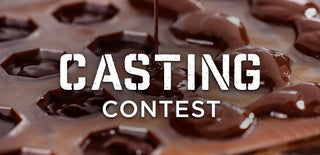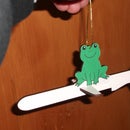Introduction: Wooden Cross With Inlay
I came across the idea of making inlays in wood using molten sulfur in a book on furniture and thought I'd give it a go.
The technique requires a thin (1/16” to 3/16” (1.5mm to 4mm)) groove to be carved in timber, into which molten sulfur is poured. This solidifies, expanding slightly as it sets which locks it into place. Once the sulfur is cool, excess can be planed off and the result is a neatly edged inlay in yellow, which ages to white.
There is very little on-line about the technique, so I thought I'd give it a go. I'm sure that there will be many competition entries for casting metal, resin and chocolate, but if you want to cheer for the maverick, please vote for the sole sulfur-casting entry in the Casting Competition :-)
To try this for yourself, all you need is some way of carving a groove in wood, some flowers of sulfur (try your local gardening store or vet) and a camping stove or heat gun. You also need to read the section on safety at the end of this 'Ible.
Step 1: Design
One problem with trying to copy the wonderful examples of the art from eighteenth-century Pennsylvania is that I can't carve. To match the project to my skills and background, I decided to try inlaying a wooden cross with a geometric interpretation of Celtic knotwork.
To draw the design, I started by sketching freehand. As you can see in the photograph above, I started in the wrong place and ended up drawing the thing upside down. The rough idea was there, but to get something which I could work from, I needed an accurate grid on which to draw.
This website, incompetech.com, is wonderful in that it provides all sorts of graph papers which can be downloaded as PDFs and printed. To match the diagonals and the uprights, I chose one which had a square grid, with another square grid overlaid at 45 degrees. The PDF for that is attached above.
Once the design was sketched in thick Sharpie, I placed some lines of double-sided sticky-tape on the back and then stuck the template to the piece of wood so that I could mark the points. The timber I used was a scrap piece of 2”x10” about a foot long. This proved to be a mistake, so please use a knot-free piece for your projects.
Attachments
Step 2: Tools, Materials and Laying-Out
With the design taped to the workpiece, I used an awl to put a small mark in the timber at every place where the line of the knotwork changed direction. Once the paper was removed, there was the outline of the design marked in eighteen holes.
Using the design as an aide-memoire, I marked where the various grooves would be using a straight-edge and a pencil.
Then I used a drill bit slightly smaller than my narrowest chisel (3.5mm for a 4mm chisel) to put a clear and obvious hole where each awl mark had been, drilling down a few mm (say 1/4").
Step 3: Carving Out the Lines
Using a craft knife and a straight-edge I scored lines where the sides of the channels should be. I used the chisel itself as the straight-edge so that the lines would be the correct distance apart.
I used the wide chisel and the mallet to give a good edge to where the cut would be. I mated the point of the freshly sharpened chisel into the cut left by the knife and gave the butt of the chisel a gentle whack with the mallet.
Once the sides of the groove were established, I used the narrow chisel and hand pressure to gently feather the wood out of the cut. I made one pass starting at the far end of a cut and working back one or two mm at a time (1/8" or 1/16") and then turned around and repeated the exercise in the opposite direction. This left a neat channel about 4mm (say 3/16") deep.
I had to take special care at the corners, where the point was liable to break off. In those areas, I used repeated, gentle passes with the craft knife to separate the wood fibres.
Step 4: Melting and Pouring the Sulphur
Sulfur melts at 107centigrade (225F), just above the nominal boiling point of water.
I did not want to melt the sulfur in my kitchen as it does smell a little, so I used a heat gun, designed for paint-stripping to provide the required heat. This produced air at 400 (750F) which provided enough heat input while convection and radiation from the ladle provided appropriate cooling.
Sulfur has a pretty poor thermal conductivity, so once it started to melt I had to keep stirring the ladle and pushing the unmelted bits underneath the surface of the hot liquid in order to get them to melt too.
Once most of the ladle had melted, I poured it into a couple of the grooves. It didn't matter that I overfilled them, as the idea is to scrape off excess and sulfur is pretty cheap. It took three more pours to fill all of the grooves in the wood, which was then left to cool for a short while.
Step 5: Cleaning Off the Surface
Traditionally a furniture scraper was used to remove excess sulfur, but lacking anything like that I used a plane.
The sulfur comes off very easily as it is quite frangible, but remains in the groove as the sulfur expands a little as it sets, giving a good mechanical grip.
I planed the sulfur overfill, then carried on planing both wood and sulfur together to remove the surface pink dye which shows the wood is H1.2 construction grade. This took way longer than it should have, and if you are using similar timber, I'd recommend 1) not, 2) running it through a planer before you start.
The sulfur powder makes a bit of a mess, so I totally dismantled the plane after this step and gave it a very thorough cleaning.
After planing, I sanded the top surface with 80 through to 220 grit sandpaper.
Step 6: Cutting the Cruxiform
I used a steel ruler as a handy inch width, and laid it alongside the outside of the inlay. Then I drew a pencil line outside of that, to give a cross shape a couple of inches wider than the inlay.
To give the Celtic look a bit of help, and to make cutting out less exacting, I used a 25mm (1") forstner bit to put a hole centred at each point where the arms met the upright. This was drilled right through the workpiece.
Then I clamped the piece to the bench and used a tennon saw to cut along the remaining pencil lines.
Step 7: Edging, Sanding and Finishing
With ogee bit, I ran the router all round the edge of the piece to give a smoother transition. This also softened the visual impact of the circle in the inner corners and made the whole thing look much better.
Then I went over the rough edges from sawing and routing with the sandpaper, including the inside of the circular holes.
Lastly some Danish Oil, applied with cotton rag and buffed off the same way.
Step 8: Safety
Lungs:-
This site here is one of the few to discuss the technique. The author goes into a number of reasons why they think this is a bad technique. I have to say that I disagree. I have asthma and had no issues casting sulfur, but of course every body is different, your own risk. The fumes were a lot less troubling than visiting a volcanic area like Yellowstone or Wai-o-Tapu (other geothermal wonderlands are available). I would recommend not melting the sulfur in a pot to be used for cooking, nor in a house, and generally the usual "well ventilated" caveats should apply. I stood at the front of my garage with the door open, but under cover and that was fine.
Fire:-
The wikipedia page for sulfur says that it burns with a blue flame. I disagree and say that it burns with no flame at all. An early trial used a small campfire to melt the sulfur, and that set the sulfur alight, with absolutely no visible sign. It was only when the wood on the test piece started to char that I realised there was a fire. I recommend against using any form of naked flame to heat the sulfur. The heat gun which I used provided enough heat at half-power. a thin piece of plywood to smother any burning inlay, and a bucket of water in which to dump any burning ladle etc is a good precaution.
PPE:-
As always when working with hot stuff, be very careful.
General:-
The first photograph above shows a nasty burn which I got. I got it from lifting the casserole with my dinner in it out of the oven, not from the sulfur casting. Therefore, sulfur casting is safer than cooking dinner. For maximum safety, do your sulfur casting and then visit McD's (other restaurants are available).
Step 9: Mistakes, Recoveries and Improvements
Mistakes and Recoveries:-
Despite great care, there were a couple of places where I sheared off the nose of a corner. The first photograph above shows one such place, and the second the dab of glue with which it was fixed.
The third photograph shows the rear of the piece of timber, complete with obvious crack. Despite being given a brace during early construction (fourth photo) the crack continued to develop. I managed to introduce some glue into the crack using a toothpick and some sewing thread and then clamped it. Fingers crossed that will hold, but using better quality wood (i.e. not dumpster-dived) would be a definite idea.
Future improvements:-
The piece looks OK, but the contrast between the wood and the sulfur is not all it might be. The wood will darken with age, while the sulfur should whiten (good technical article here). It might be good fun to try some accelerated ageing cycles and see if that can be brought to fruition in weeks rather than decades.
Using a CNC cutter would allow much nicer (curvy) knotwork to be done. I'd want a 2-3mm groove (3/32" to 1/8") as the sulfur can leave a void at wider points.
Making a piece using a dense hardwood would give a nicer contrast, but would probably need chisels sharper than I can manage.

Participated in the
Casting Contest














